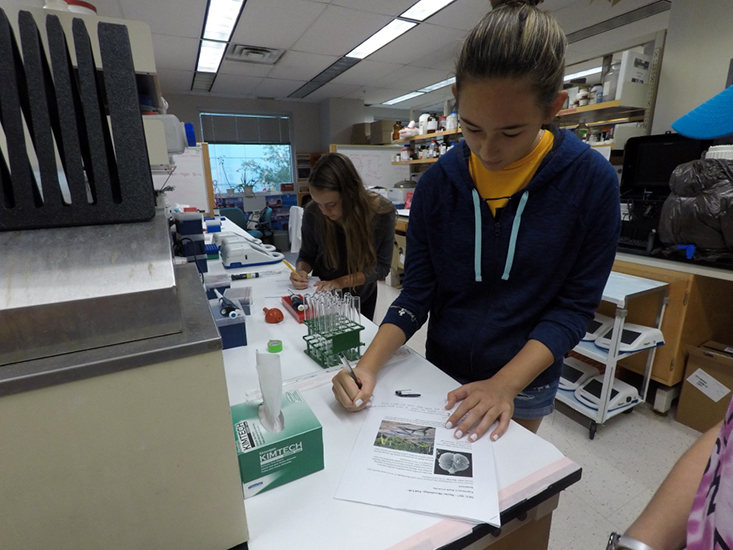Blog post by Dr. Lauren McDaniel & Makenna Martin with photos provided by OCG Staff.
The marine microbiology lab had four main activities for the campers to do: learning about Red Tide cells (algal cells called Karenia Brevis) and experimenting with household items that might be able to kill the cells, looking at bacterial counts on human hands and experimenting with the antibacterial properties of hand sanitizer and soap, doing a plankton tow and looking at the plankton samples underneath a microscope, and extracting DNA from strawberries.
Part 1: Karenia brevis is a dinoflagellate that produces toxins called brevetoxins. K. brevis causes harmful algal blooms called “Red Tide” in the Gulf of Mexico. Red tides can affect human health by causing respiratory problems from inhaling aerosolized brevetoxins or ingesting toxins from tainted seafood (referred to as Neurologic Shellfish Poisoning or NSP). However, no human mortalities have been attributed to K. brevis intoxication. Red tide blooms are devastating to marine life, causing fish kills, marine mammal mortality, seabird mortality, and hypoxic zones. In terms of economic impact, red tides cause millions of dollars of lost revenue to hotels, restaurants, and tourism annually.
Campers were posed with a research question: Which household item will kill more Red Tide cells, hydrogen peroxide or Diet Coke? They wrote down their hypotheses, and proceeded to count the number of Red Tide cells in a provided sample. Then, after obtaining the baseline count, the campers added hydrogen peroxide to one sample, Diet Coke to another, and left a third as the control sample. The counted the number of cells remaining after 2 hours and again the following day.
Part 2: Hand Sanitizer versus Soap and Water. Your hands are the simplest effective way to spread germs and infections to others. Keeping them clean is important to avoid getting sick. There are many methods to maintain proper hand hygiene, such as washing them with soap and clean water or by rubbing them with antimicrobial alcohol-based sanitizer. In this lab campers aimed to investigate which method better prevents bacterial growth.
The campers swabbed their hands after washing them with soap and water or cleaning them with hand sanitizer and incubated the bacteria in petri dishes. One interesting finding of the first lab group was that the campers with hands washed in soap and water actually had more bacteria grow on their petri dishes than the untreated hands! Campers hypothesized that the towel used to dry their hands after washing may have been contaminated.
Part 3: Campers towed a fine mesh net, known as a plankton tow, along the seawall in front of the College of Marine Science. After collecting the samples, they placed them under the microscope to see what they could find! Many were surprised to see so much life living in such a tiny sample.
Part 4: Extracting DNA from a strawberry is easier than you might think! A method using just a few household items allows campers to see the strands of DNA spool together in strings. After pulverizing the strawberries, adding a meat tenderizer degrades the proteins enough to separate out the DNA. Then by adding rubbing alcohol, the strands of DNA are separated out because DNA is not soluble in alcohol. This lab showed the campers that DNA is everywhere, even in the foods we eat!
